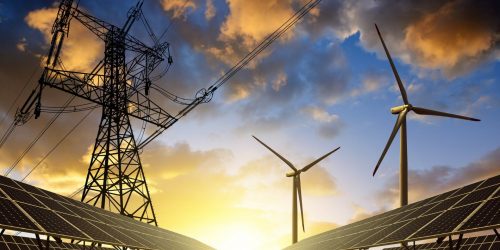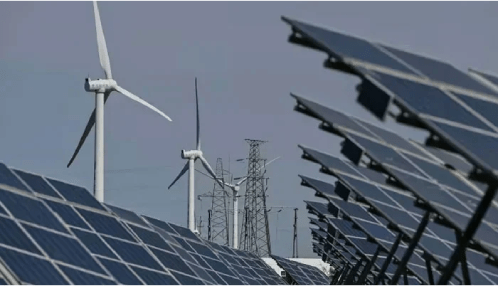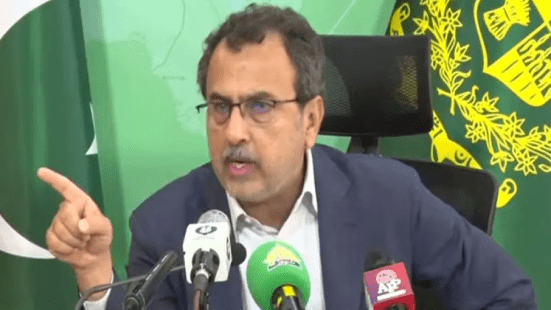There are two types of energy: renewable and non-renewable. Non-renewable energy includes the resources from coal, gas and oil. They are made by burning fossil fuels to create energy. Renewable energy, often referred to as clean energy, comes from natural resources or processes that are constantly replenished. The renewable energy sources are solar energy, wind energy, hydropower, geothermal energy, and biomass energy.
Renewable energy sources make upto 26% of the world’s electricity today, but according to the International Electricity Agency, IEA its share is expected to reach more than 30% by 2024. Overall, renewable electricity is predicted to grow by 1200 GW by 2024 all over the world, which is equivalent of the total electricity generation capacity of the USA.
According to data compiled by the U.S. Energy Information Administration, there are seven countries already at, or very, near to 100 percent renewable power: Iceland (100 percent), Paraguay (100), Costa Rica (99), Norway (98.5), Austria (80), Brazil (75), and Denmark (69.4). The main renewables in these countries are hydropower, wind, geothermal, and solar.
Bloomberg New Energy Finance (BNEF) has projected that by 2040, Germany’s grid will see nearly 75 percent renewable penetration, Mexico will be over 80 percent, and Brazil and Italy will be over 95 percent. BNEF was not looking at what could theoretically happen by mid-century if countries pushed as hard as required by the Paris Climate Accord. They were just looking at business as usual over the next two decades.
After the emergence of Pakistan on the world’s map, in the decades of 60’s and 70’s, the hydropower power generation projects were constructed and electricity on cheaper rates was provided to the nation. These projects included Warsak, Mangla and Tarbela hydropower projects. Because of the cheaper electricity available in that era, the industry of Pakistan was on the rise. Hydropower is considered to be the cheapest form of thepower generation then and today.In the decades of 80’s and 90’s our governments introduced new power generation policy in private sector because of which the IPPs were introducedfor thermal power generation. Under these contracts with IPPs, very expensive power generation projects were built, which caused the price of electricity to rise sky high. Today the situation in the country is that more than 60% of the total generation capacity is generated from thermal projects in which more than 50% by IPPs while about 10% by the public sector. Only about 25% of the total generation capacityis hydropower andthe remaining 10 to 15 percent comes from solar, wind, nuclear and other resources.
Still with over half of the rural population unable to access electricity, Pakistan is rightfully undertaking a major build-out of electricity generation capacity to meet demand growth into the future
The Developed and many developing countries around the world are now turning to renewable energy, including Hydropower, Solar power and Wind power projects are at the forefront.The benefits of renewable energy are enormous. This type of power generation does not harm the environment and iscalled the Green Energy while thermal power generation makes the environment very much polluted.
In the past, solar and wind power projects used to cost a lot and alsothe unit price of electricity generated from them was very high, but over the time, the cost of all the machinery of such projects, the cost of construction, installation and operating them has decreased significantly and will gradually going on decreasing in the coming days.
If we talk about the previous solar power project Quaid-e-Azam Solar Park, built in 2014-15, which had a capacity of 100 MW but it is generating only 18 to 25 megawatts of electricity, and power generation is also quite expensive. The project is generating electricity at a rate of about Rs. 24 per unit.Similarly, from past wind power projects, electricity is very expensive and it costs around Rs. 20 to 22 per unit.
With the passage of time, the cost of solar and wind power projects has come down significantly and the electricity generated from them is now around Rs. 6 to Rs. 7 per unit refer to the new wind and solar energy contracts signed recently by the present Government in 2020.
The Pakistan Meteorological Department conducted a study in 2013 entitled “Wind Power Potential Survey of Coastal Areas of Pakistan”, which the Ministry of Science & Technology provided funding for. This study enabled PMD to identify potential “wind corridors” where economically feasible wind farm could be established. The Gharo-Jhimpir wind corridor in Sindh was identified as the most lucrative site for wind power plants. The wind power potential covered an area of 9700 km with a gross wind power potential of 43000 MW. Similarly, near the Pakistan Iran and Afghanistan borders in Baluchistan, there is a big wind corridor, which can be developed in future. There is another one in Swat, KPK which can be developed also.
As per Alternative Electricity Development board, AEDB, at present, twenty-Four (24) wind power projects of 1235.20 MW cumulative capacity have achieved Commercial Operation and are supplying electricity to National Grid while Twelve (12) wind power projects of 610 MW capacity have achieved Financial Closing and are under construction.Six (06) solar power projects of 430 MW capacity are operational while (04) IPPs with a cumulative capacity of 41.80 MW are in the process of achieving Financial Closing of their projects and other Twelve (12) Solar PV power projects of 419 MW cumulative capacity are at different stages of project development.
Still with over half of the rural population unable to access electricity, Pakistan is rightfully undertaking a major build-out of electricity generation capacity to meet demand growth into the future. Further adoption of ever-cheaper and accessible renewable energy can make a greater contribution towards meeting Pakistan’s growing electricity demands. Instead, Pakistan is currently on an energy pathway towards over-reliance on imported fossil fuels and out-dated coal technology.
The Institute for Energy Economics and Financial Analysis (IEEFA) of Pakistan has modelled a high level, alternative future for Pakistan’s electricity system that addresses cost burdens and energy security.
In IEEFA’s model, the renewables through wind and solar supplying 28% of Pakistan’s increasing electricity requirements by 2030. Generation costs would be reduced and energy security increased through a diversity of generation technologies roughly split 30:30:30:10 between renewable energy through wind & solar, thermal power, hydro power, and nuclear power.
Pakistan needs to focus on projects that provide us with the cheapest electricity. Pakistan cannot afford expensive electricity i.e. thermal power. All our industries need cheaper electricity so that the industry can flourish and our GDP growth can beimproved along with the increase in Pakistan’s exports. In the future, the cheaper electricity can only come from renewable energy projects. Therefore, our present and future governments will have to focus only on renewable energy projects, i.e. hydropower, solar power and wind power. So that Pakistan can get out of troubles and in next 5 to 10 years, Pakistan will be in the list of fastest growing countries Insha-Allah.







